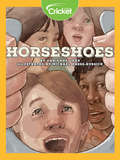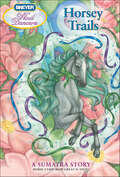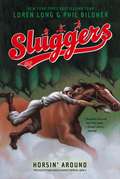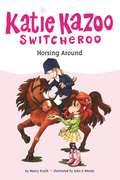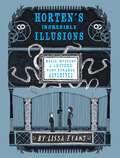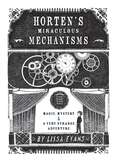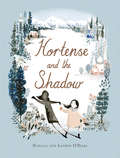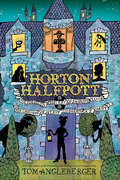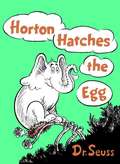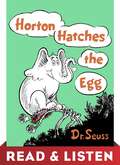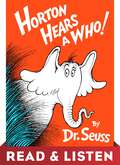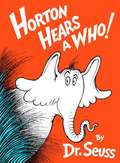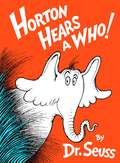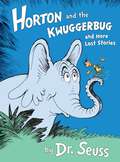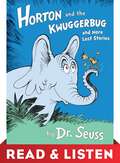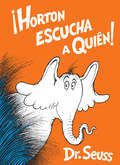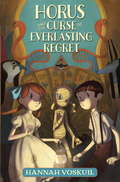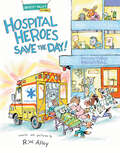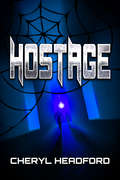- Table View
- List View
Horseshoes
by Darienne OaksA young girl feels like she doesn't fit in because her father is disabled. But when her dad puts on his strongman act for the neighborhood kids, she realizes how special he truly is.
Horsey Trails: A Sumatra Story (Wind Dancers)
by Sibley MillerThe Wind Dancers—Kona, Brisa, Sumatra, and Sirocco—are back with four more full-color illustrated titles sure to delight the imaginations of horse-loving little girls everywhere.Trail rides, camping out in tents, classic activities. Horse camp sounds great—especially to four fanciful horses! Will the Wind Dancers enjoy their rugged outing among the big horses and campers, or will they become homesick for the comforts of home sweet tree house? For bonus information, contests, and more Wind Dancers fun, visit the Breyer Wind Dancers Website.
Horsin' Around
by Loren Long Phil BildnerThe year is 1899, and the Travelin' Nine are crisscrossing the good ol' U.S. of A., raising money to pay off the Payne family's big-league debt! As the team heads into the River City, Griffith is beginning to realize that there's more at risk than meets the eye, something beyond the need to raise money -- something involving the ball that could put his entire family in danger. Ruby is eager to help solve the mystery of the ball and plans on keeping her eyes and ears wide open and writing everything down. She knows the answer is out there. All she has to do is see the things that others don't. And figure out what those things mean. Then there's Graham, who usually only thinks about how to get more time on the baseball field. Even he's beginning to notice that there are strange and shady characters at just about every turn. Finally there's the Chancellor, one of the wealthiest and greediest businessmen in the entire world. And it looks like he's got his eye on the ball!
Horsing Around #30
by Nancy Krulik John WendyBecky is taking riding lessons at the Cherrydale Stables. That's not news to Katie or her friends: In fact, they are sick of hearing about horses and sick of hearing Becky brag about what a great rider she is. Still, Katie convinces everyone to go to the horse show where Becky wins a medal in the first event, showmanship. The event looks pretty easy. However, Katie gets to see what it's like from the horse's perspective when suddenly she's switcherooed into Becky's horse Brownie.
Horsing Around (Katie Kazoo Switcheroo #30)
by Nancy KrulikBecky is taking riding lessons at the Cherrydale Stables. That's not news to Katie or her friends. In fact, they are sick of hearing about horses and sick of hearing Becky brag about what a great rider she is.
Horsing Around: Jokes to Make You Smile (Make Me Laugh)
by Joanne E. Bernstein Peter Roop Connie Roop Rick Walton Diane L. Burns Dan Scholten Ann Walton Paul CohenA collection of jokes about farm animals.
Horten's Incredible Illusions: Magic, Mystery & Another Very Strange Adventure
by Lissa EvansThis magical follow-up to Hortens Miraculous Mechanisms continues Stuarts amazing adventures--with more enchantment, more surprises, and more thrills. When we last left 10-year-old Stuart, he had just recovered his great-uncle Tonys long-lost magic workshop. Now all the priceless tricks are on display in the Beeton Museum--and Stuart is junior curator of the exhibit! But another mystery awaits Stuart: Where did the great magician hide his will? Only by entering the magic world of the workshop can he find the answer. But as the mechanisms whisk him off on increasingly incredible adventures, the puzzles become harder and harder to solve…and the stakes higher. With even more page-turning action, this second book in the exciting middle-grade series does a magic trick of its own: its even better than the first!
Horten's Miraculous Mechanisms: Magic, Mystery, & a Very Strange Adventure
by Lissa EvansEnter a wonderful world filled with real magic, mystery … and danger. As if being small for his age and also having S. Horten as his name isnt bad enough, now 10-year-old Stuart is forced to move far away from all his friends.But on his very first day in his new home, Stuarts swept up in an extraordinary adventure: the quest to find his great-uncle Tony--a famous magician who literally disappeared off the face of the earth--and Tonys marvelous, long-lost workshop. Along the way, Stuart reluctantly accepts help from the annoying triplets next door… and encounters trouble from another magician whos also desperate to get hold of Tonys treasures.A quirky, smart, charming page-turner, Hortens Miraculous Mechanisms will enchant young readers--as well as teachers, librarians, and parents. Long-listed for the Carnegie Medal (2012) and the Guardian Childrens Fiction Prize (2011)
Hortense and the Shadow
by Lauren O'Hara Natalia O'HaraA haunting, original fairy tale from two dazzling debut picture book talents, in the spirit of Neil Gaiman and Carson Ellis. Hortense is a kind and brave girl, but she is sad--even angry--that her shadow follows her everywhere she goes. She hates her shadow, and thinks her shadow must hate her too. But one cold, dark night, when bandits surprise her in the woods, Hortense discovers that her shadow is the very thing she needs most.This stunningly illustrated story stirs the soul with its compelling, subtle exploration of self-esteem, self-identity, and finding inner strength.
Horton Halfpott: Or, The Fiendish Mystery of Smugwick Manor; or, The Loosening of M'Lady Luggertuck's Corset
by Tom AnglebergerA servant boy becomes an unlikely hero when a thief strikes in this humorous historical mystery by the author of The Strange Case of Origami Yoda. There are so many exciting things in this book—a Stolen Diamond, snooping stable boys, a famous detective, love, pickle éclairs—that it really does seem a shame to begin with ladies&’ underwear . . . It all starts when M&’Lady Luggertuck loosens her corset. As a result of &“the Loosening,&” all the strict rules around Smugwick Manor are abandoned. Shelves go undusted! Cake is eaten! Lunch is lukewarm! Then, when the precious family heirloom, the Luggertuck Lump (quite literally a lump), goes missing, the Luggertucks search for someone to blame. Could the thief really be Horton Halfpott, the good-natured but lowly kitchen boy who can&’t tell a lie? A colorful and hilarious cast comes together in this entertaining mystery, Tom Angleberger&’s loopiest novel yet!Praise for Horton Halfpott &“A positively gleeful historical mystery farce. . . . A satirical homage to Dickens by way of Pratchett and Snicket. Short chapters, a fast pace and plenty of linguistic and slapstistic humor will have young readers hoping that a sequel is planned. The scribbly pen-and-ink chapter-heading cartoon illustrations are just icing on the cake—or pickle éclair. A romp from start to finish.&” —Kirkus Reviews &“Angleberger delivers many spoonfuls of sugar alongside the moral of this Victorian fable.&” —Shelf-Awareness &“Readers are in for a treat.&” —Publishers Weekly
Horton Hatches the Egg
by Dr SeussMayzie is tired of sitting on her nest, but what other animal could give her some rest? Not a cow! Not a horse! Surely not Horton! He's bigger than a horse! But Horton is kind, And his word is true. Horton hatches that egg! Dear reader, it's true! This file should make an excellent embossed braille copy. .
Horton Hatches the Egg (Classic Seuss)
by Dr. SeussThe Dr. Seuss classic that first introduced Horton the Elephant!Beloved by generations for his kindness and loyalty, Horton the Elephant is one of the most iconic and honorable characters in children's literature—as well as the star of two books and a short story by Dr. Seuss (Horton Hatches the Egg, Horton Hears a Who!, and "Horton and the Kwuggerbug.") In this book—the comic classic in which Horton utters the line "I meant what I said, and I said what I meant. . . . An elephant's faithful, one hundred per cent!"—we see his integrity rewarded with a surprise ending that will delight readers of all ages. Told with Dr. Seuss's signature rhymes and trademark illustrations, this is a tale that will be enjoyed over and over, by reader and listener alike. It makes a perfect gift for birthdays and holidays, and is ideal for sparking discussions about kindness, values, and loyalty.
Horton Hatches the Egg: Read & Listen Edition (Classic Seuss)
by Dr. SeussMeet Horton the elephant, one of the most commendable heroes in children&’s books. &“I meant what I said, and I said what I meant. . . .An elephant&’s faithful, one hundred per cent!&”Horton is kind and trustworthy, but unfortunately, the lazy bird Mayzie takes advantage of his good nature when she leaves Horton to watch her unhatched egg. Told with Dr. Seuss&’s signature rhymes and trademark illustrations, this is a tale that will be enjoyed over and over, by reader and listener alike. And don&’t miss another delightful tale about this beloved pachyderm: Horton Hears a Who! This Read & Listen edition contains audio narration.
Horton Hears A Who! Read & Listen Edition (Classic Seuss)
by Dr. SeussHorton is back! After his first appearance in Horton Hatches the Egg, everyone&’s favorite elephant returns in this timeless, moving, and comical classic in which we discover that &“a person&’s a person, no matter how small.&” Thanks to the irrepressible rhymes and eye-catching illustrations, young readers will learn kindness and perseverance (as well as the importance of a good &“Yopp&”) from the very determined—and very endearing—Horton the elephant. This Read & Listen edition contains audio narration.
Horton Hears a Who!
by Dr Seuss"After all! A person's a person. No matter how small!" Other books by Dr. Seuss are available from Bookshare.
Horton Hears a Who! (Classic Seuss)
by Dr. SeussChoose kindness with Horton the elephant and the Whos of Who-ville in Dr. Seuss's classic picture book about caring for others! The new matte finish cover makes it a perfect gift! A person's a person, no matter how small.Everyone's favorite elephant stars in this heartwarming and timeless story for readers of all ages. In the colorful Jungle of Nool, Horton discovers something that at first seems impossible: a tiny speck of dust contains an entire miniature world--Who-ville--complete with houses and grocery stores and even a mayor! But when no one will stand up for the Whos of Who-ville, Horton uses his elephant-sized heart to save the day. This tale of compassion and determination proves that any person, big or small, can choose to speak out for what is right. This story showcases the very best of Dr. Seuss, from the moving message to the charming rhymes and imaginative illustrations. No bookshelf is complete without Horton and the Whos!Do you see what I mean? . . . They've proved they ARE persons, no matter how small. And their whole world was saved by the Smallest of All!
Horton and the Kwuggerbug and More Lost Stories (Classic Seuss)
by Dr. SeussA follow-up to The Bippolo Seed and Other Lost Stories by Dr. Seuss! A new Dr. Seuss book! This follow-up to The Bippolo Seed and Other Lost Stories features familiar Seussian faces and places—including Horton the Elephant, Marco, Mulberry Street, and a Grinch—as well as an introduction by renowned Seuss scholar Charles D. Cohen. Seuss fans will learn more about Horton&’s integrity, Marco&’s amazing imagination, a narrowly avoided disaster on Mullbery Street, and a devious Grinch. With a color palette enhanced beyond that of the magazines in which the stories originally appeared, this new volume of &“lost&” tales is a perfect gift for young readers and a must-have for Seuss collectors of all ages!
Horton and the Kwuggerbug and more Lost Stories: Read & Listen Edition (Classic Seuss)
by Dr. SeussA follow-up to The Bippolo Seed and Other Lost Stories by Dr. Seuss! A new Dr. Seuss book! This follow-up to The Bippolo Seed and Other Lost Stories features familiar Seussian faces and places—including Horton the Elephant, Marco, Mulberry Street, and a Grinch—as well as an introduction by renowned Seuss scholar Charles D. Cohen. Seuss fans will learn more about Horton&’s integrity, Marco&’s amazing imagination, a narrowly avoided disaster on Mullbery Street, and a devious Grinch. With a color palette enhanced beyond that of the magazines in which the stories originally appeared, this new volume of &“lost&” tales is a perfect gift for young readers and a must-have for Seuss collectors of all ages!This Read & Listen edition contains audio narration.
Horton cuida un nido (Classic Seuss)
by Dr. Seuss¡Edición en español y rimada del clásico de Dr. Seuss en el que se nos presenta por primera vez a Horton el elefante! Querido durante generaciones por su bondad y lealtad, Horton el elefante es uno de los personajes más icónicos y respetados de la literatura infantil. En este libro, en el que Horton pronuncia las palabras «Va en serio lo que dije, y lo que dije así lo siento… Un elefante es leal, ¡y es leal al cien por ciento!», vemos recompensada su integridad con una sorpresa final que encantará a los lectores de todas las edades. Las ediciones rimadas en español de los clásicos de Dr. Seuss, publicadas por Random House, brindan la maravillosa oportunidad de disfrutar de sus historias a más de treinta y ocho millones de personas hispanohablantes en Estados Unidos. Los lectores podrán divertirse con las ediciones en español de The Cat in the Hat (El Gato Ensombrerado); Green Eggs and Ham (Huevos verdes con jamón); One Fish, Two Fish, Red Fish, Blue Fish (Un pez, dos peces, pez rojo, pez azul); The Lorax (El Lórax); Oh, the Places You'll Go! (¡Oh, cuán lejos llegarás!); How the Grinch Stole Christmas! (¡Cómo el Grinch robó la Navidad!); The Cat in the Hat Comes Back (El Gato Ensombrerado ha regresado); I Can Read Wwth My Eyes Shut! (¡Yo puedo leer con los ojos cerrados!); Horton Hears a Who! (¡Horton escucha a Quién!); The 500 Hats of Bartholomew Cubbins (Los 500 sombreros de Bartolomé Cubbins); There's a Wocket in My Pocket! (¡Hay un Molillo en mi Bolsillo!); Mr. Brown Can Moo! Can You? (¡El Sr. Brown hace Muuu! ¿Podrías hacerlo tú?); Ten Apples Up on Top! (¡Diez manzanas en la cabeza!); What Pet Should I Get? (¿Cómo podré decidir qué mascota elegir?); Yertle the Turtle and Other Stories (Yoruga la Tortuga y otros cuentos); Oh, the Thinks You Can Think! (¡Oh, piensa en todo lo que puedes pensar!); The Foot Book! (¡Cuántos, cuántos pies!); Happy Birthday to You! (¡Feliz cumpleaños!); Come Over to My House (Ven a mi casa); Dr. Seuss's Sleep Book (¡Dormilones!); Would You Rather Be a Bullfrog? (¿Preferirías ser una rana?); Horton Hatches the Egg (Horton cuida un nido); y Dr. Seuss's 1 2 3 (Cuenta con Dr. Seuss 1 2 3). A rhymed, Spanish edition of the Dr. Seuss classic that first introduced Horton the Elephant! Beloved by generations for his kindness and loyalty, Horton the Elephant is one of the most iconic and honorable characters in children's literature. In this book—the comic classic in which Horton utters the line "I meant what I said, and I said what I meant. . . . An elephant's faithful, one hundred per cent!"—we see his integrity rewarded with a surprise ending that will delight readers of all ages.
Horton escucha a Quién! (Classic Seuss)
by Dr. Seuss¡Edición en español y rimada del clásico de Dr. Seuss acerca de la bondad! Horton el elefante, uno de los personajes más heroicos de la literatura infantil, nos enseña en esta intemporal, conmovedora y cómica historia que «una persona es una persona, por muy pequeña que sea». Contada con el estilo de Dr. Seuss, y con sus característicos dibujos, esta edición en español será del agrado de lectores y oyentes por igual.Las ediciones rimadas, en español, de los clásicos de Dr. Seuss, publicadas por Random House, brindan la maravillosa oportunidad de disfrutar de sus historias a más de treinta y ocho millones de personas hispanohablantes en Estados Unidos. A rhymed Spanish translation of Dr. Seuss's classic picture book about kindness!Horton the elephant—one of the most heroic characters in children's literature—shows us that "a person's a person, no matter how small" in this timeless, moving, and comic classic. Told with Dr. Seuss's signature rhymes and trademark illustrations, this Spanish edition of the beloved tale that will be enjoyed over and over, by reader and listener alike.Random House's rhymed, Spanish-language editions of classic Dr. Seuss books make the joyful experience of reading Dr. Seuss books available for the more than 38 million people in the United States who speak Spanish.
Horus and the Curse of Everlasting Regret
by Hannah VoskuilA mystery-adventure in which a boy, a girl, a pet bat, and a mummy embark on a mission to find a kidnapped girl -- and reverse an ancient Egyptian curse. Peter will do just about anything to escape being bullied by his stepbrothers and go to summer camp. Across town, Tunie and her pet bat, Perch, are working hard at the bakery and the local museum to support Tunie's ailing father. When a business tycoon's daughter is kidnapped, Peter and Tunie both decide they could do with some reward money; and after a chance meeting in the Ancient Egyptian Exhibit at the museum, they team up to solve the mystery together. Things take a turn for the magical when they encounter a mummy called Horus at the exhibit. Together, this unusual trio will find themselves teaming up to rescue the girl and undo a centuries-old curse that just may be the key to it all. Filled with enchantment, history, and a little bit of luck, Horus and the Curse of Everlasting Regret is a charming adventure and a story of true friendship.
Horvos the Horror Bird: Book 15
by Adam BladeA new terror is in store for Max and Lia as they hunt for the third precious element that could save them. Horvos the Horror Bird is here, with flamethrowers on its wings!The third thrilling book in Sea Quest Series 4: The Lost Lagoon. Don't miss the rest of the series:Rekkar the Screeching Orca, Tragg the Ice Bear and Gubbix the Poison Fish!
Horvos the Horror Bird: Book 15 (Sea Quest #15)
by Adam BladeA new terror is in store for Max and Lia as they hunt for the third precious element that could save them. Horvos the Horror Bird is here, with flamethrowers on its wings!The third thrilling book in Sea Quest Series 4: The Lost Lagoon. Don't miss the rest of the series:Rekkar the Screeching Orca, Tragg the Ice Bear and Gubbix the Poison Fish!
Hospital Heroes Save the Day! (Breezy Valley at Work)
by R.W. AlleyFor fans of Richard Scarry and Busytown, this funny and informative picture book set in a hospital features lively animals as doctors, nurses, and emergency workers in a rollicking story, with detail-packed illustrations.The hospital workers of the Breezy Valley Hospital are always ready to provide top-notch medical care to the residents of their beloved town. Doctors, nurses, lab workers, kitchen staff, and maintenance workers are just a few of the staff working to keep the hospital running smoothly. And when emergencies happen, the EMTs (Emergency Medical Technicians) and their ambulance come to the rescue—like when Lemur needed to be brought to the hospital to get treatment for their injured tail! Lively action, peeks into key hospital rooms, and more will keep young readers engaged in this second title in the Breezy Valley at Work series.
Hostage
by Cheryl HeadfordWhen Astrin Raphael finds himself held hostage in an unfamiliar place, he has no option but to try to have faith in someone who seems to despise him. Little does he know his captor is his nemesis, Rowan Gabriel, whose disdain for Astrin all started with a misunderstanding years ago. The kidnapping of Astrin's father and Rowan's uncle leaves the two princes with no choice but to form a precarious alliance. Rowan casts off his hatred and reaches out to Astrin, but Astrin's doubt and insecurity run too deep to let go of easily. It's not until Astrin almost loses his life that he's able to acknowledge what Rowan means to him and admit to the love forming between them. Their struggle doesn't end when they return home and their Houses attempt to broker a deal to determine their future together. Each prince might face a choice between keeping his title and finding happiness with the man he loves.
